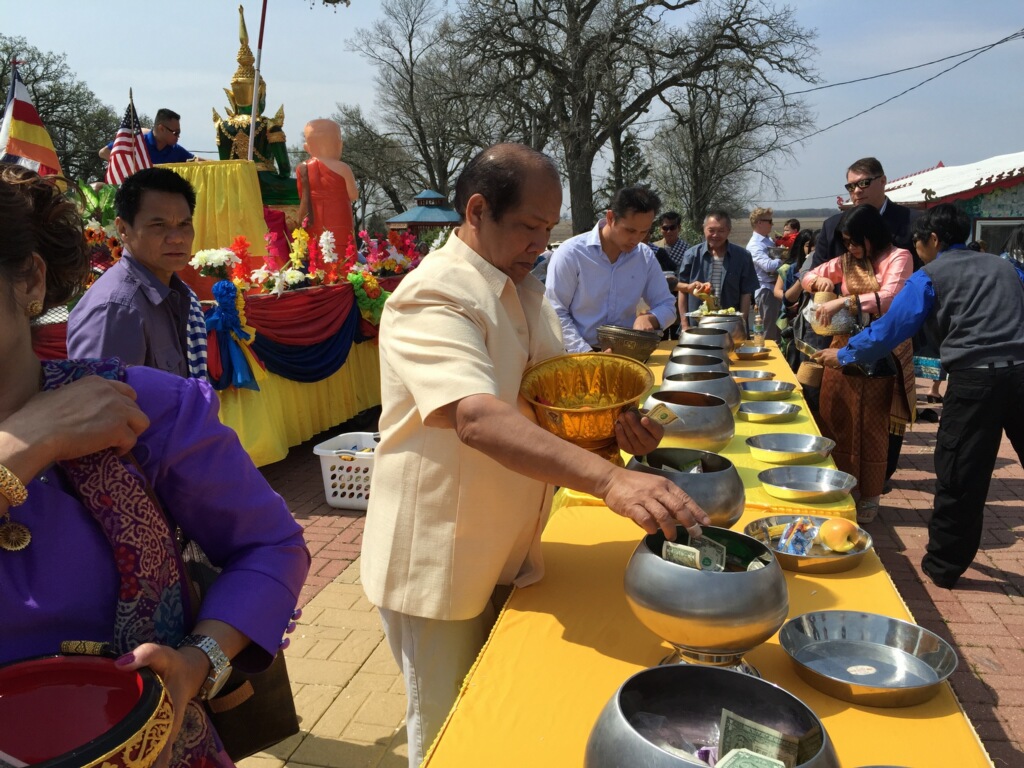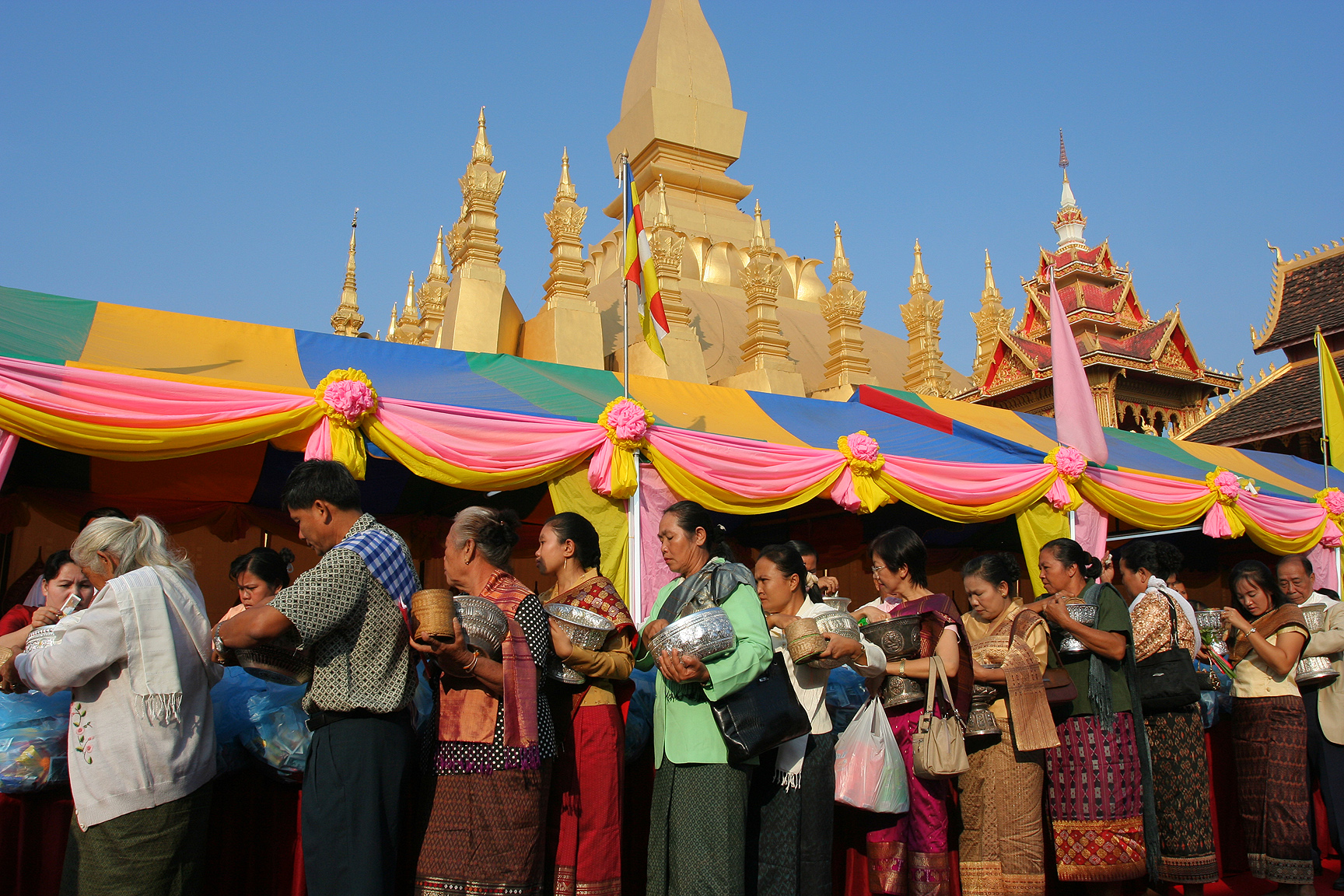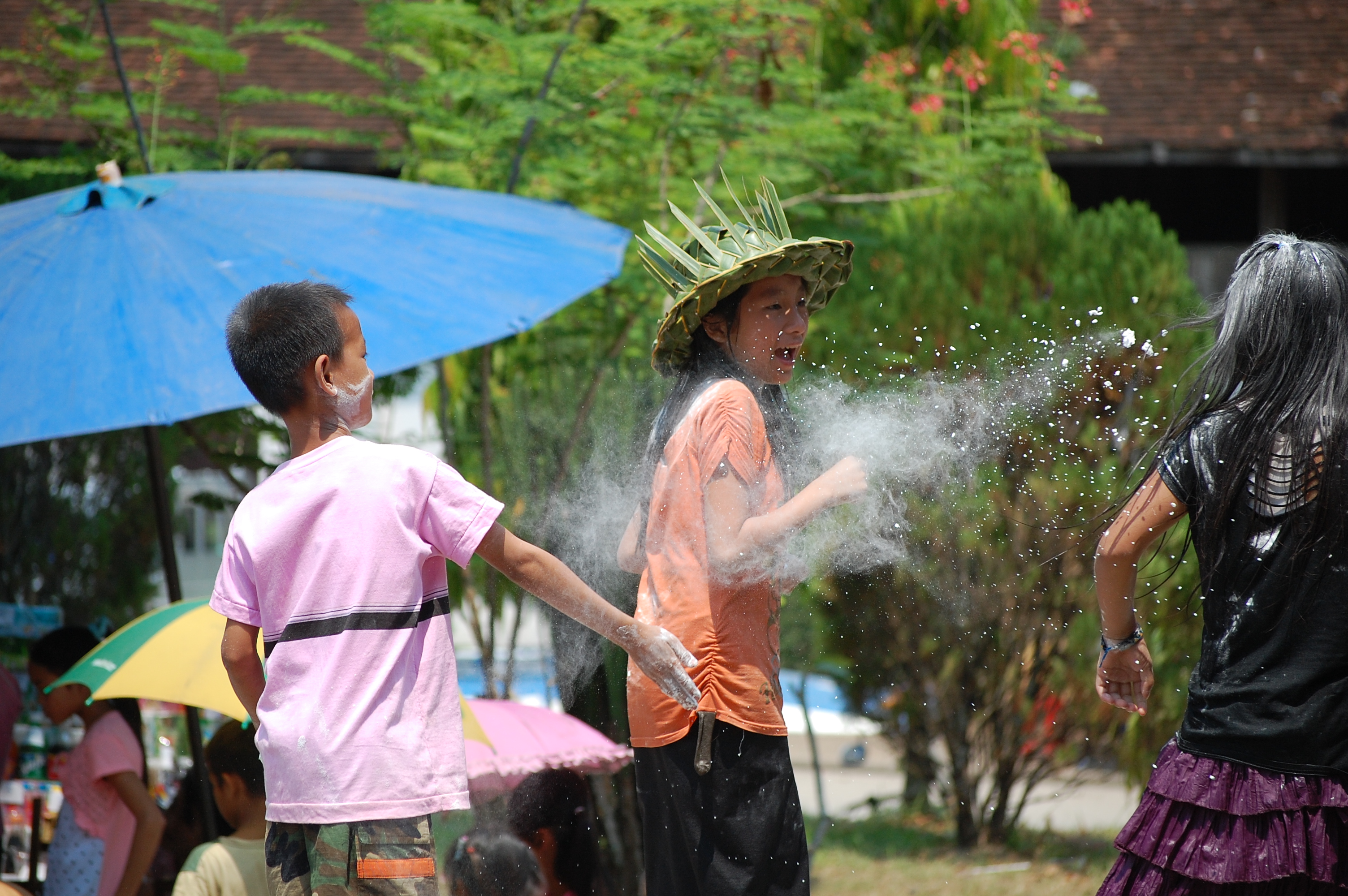|
Laotians In France
Laotians in France consist of people of Lao ancestry who were born in or immigrated to France. The population as of 2017 is estimated to be 200,000. The Laotian community in France forms the most established overseas Laotian population outside of Southeast Asia, with a presence in the country dating to before the end of the Laotian Civil War and mass refugee migration that resulted from it. History The presence of Laotian people in France began during the early 20th century, when Laos was a protectorate of France. With the steady introduction of the French education system by the colonists, a number of Laotian students were able to study in France, including members of the Lao Royal Family. A smaller number of Laotian workers also settled in France during this period. Following Laotian independence in 1953 and the Geneva Accords, a significant number of Lao continued to immigrate to France. This wave of migrants initially consisted of those loyal to the colonial government, ... [...More Info...] [...Related Items...] OR: [Wikipedia] [Google] [Baidu] |
Paris
Paris () is the capital and most populous city of France, with an estimated population of 2,165,423 residents in 2019 in an area of more than 105 km² (41 sq mi), making it the 30th most densely populated city in the world in 2020. Since the 17th century, Paris has been one of the world's major centres of finance, diplomacy, commerce, fashion, gastronomy, and science. For its leading role in the arts and sciences, as well as its very early system of street lighting, in the 19th century it became known as "the City of Light". Like London, prior to the Second World War, it was also sometimes called the capital of the world. The City of Paris is the centre of the Île-de-France region, or Paris Region, with an estimated population of 12,262,544 in 2019, or about 19% of the population of France, making the region France's primate city. The Paris Region had a GDP of €739 billion ($743 billion) in 2019, which is the highest in Europe. According to the Economist Intelli ... [...More Info...] [...Related Items...] OR: [Wikipedia] [Google] [Baidu] |
Laotian American
Laotian Americans ( lo, ຄົນອາເມລິກາລາວ) are Americans who trace their ancestry to Laos. Laotian Americans are included in the larger category of Asian Americans. The major immigrant generation were generally refugees who escaped Laos during the warfare and disruption of the 1970s, and entered refugee camps in Thailand across the Mekong River. They emigrated to the United States during the late 1970s and throughout the 1980s. The category of 'Laotian American', includes all ethnic groups who lived within the borders of Laos, and does not include Hmong community. History Laotian immigration to the United States started shortly after the Vietnam War. Refugees began arriving in the U.S. after a Communist government came to power in Laos in 1975 and by 1980, the Laotian population of the U.S. reached 47,683, according to census estimates. The numbers increased dramatically during the 1980s so the census estimated that there were 147,375 people by 1990. ... [...More Info...] [...Related Items...] OR: [Wikipedia] [Google] [Baidu] |
French Language In Laos
French is spoken by a significant minority in Laos. Laos has the second largest Francophone community in Southeast Asia after Vietnam, with Cambodia coming in third. French is used as a diplomatic and commercial language and is also studied by over a third of students in Laos. Consequently, French enjoys a healthier status in Laos than in Vietnam and Cambodia, although it is still under threat from the encroaching use of English. History The French language was introduced to Laos in the 19th century when French explorers arrived in Laos trying to make inroads into China after colonizing Vietnam. The French did not pay much attention to the kingdom of Lan Xang but established a consulate in present-day Luang Prabang. The actual catalysts for the establishment of colonial protectorate over Lao cultural regions were French fears of economic and political competition from Britain. By the 1890s, border disputes with Siam and France led to the Franco-Siamese War and the borders of Lao ... [...More Info...] [...Related Items...] OR: [Wikipedia] [Google] [Baidu] |
History Of Laos
Evidence for modern human presence in the northern and central highlands of Indochina, that constitute the territories of the modern Laotian nation-state dates back to the Lower Paleolithic. These earliest human migrants are Australo-Melanesians—associated with the Hoabinhian culture—and have populated the highlands and the interior, less accessible regions of Laos and all of South-east Asia to this day. The subsequent Austroasiatic and Austronesian marine migration waves affected landlocked Laos only marginally and direct Chinese and Indian cultural contact had a greater impact on the country.Pittayaporn, Pittayawat (2014). Layers of Chinese loanwords in Proto-Southwe ... [...More Info...] [...Related Items...] OR: [Wikipedia] [Google] [Baidu] |
Kayane
Marie-Laure Norindr (born 17 June 1991 in Paris), also known as Kayane (), is a French esports player and journalist. She specializes in fighting games, in particular in the '' Dead or Alive'', ''Soulcalibur'' and ''Street Fighter'' series, and has been playing competitively since 2001. Since then, according to ''Guinness World Records'' in 2011, she has been the most successful female participant in fighting game tournaments, especially regarding the ''Soulcalibur'' games. She is currently sponsored by Red Bull. Biography Marie-Laure Norindr was born on 17 June 1991 in Paris and grew up in Argenteuil, a north-western suburb. She is of Laotian and Vietnamese descent and her nickname Kayane comes from conjunction of the names of '' Dead or Alive'' characters Kasumi and Ayane. Kayane has played video games since her early childhood, interested in a variety of genres. In 2001, she won the second place in France's vice-champion in '' Dead or Alive 2'' at an age of nine; it was the ... [...More Info...] [...Related Items...] OR: [Wikipedia] [Google] [Baidu] |
Billy Ketkeophomphone
Billy Ketkeophomphone ( ; born 24 March 1990) is a professional footballer who plays as a striker . Born in France, he represents the Laos national team at international level. Club career Early career Born in Champigny-sur-Marne, Ketkeophomphone began his career with Racing Paris, before joining the prestigious Clairefontaine academy in 2003. After three years, he left the club to sign for Strasbourg. In summer 2008, he was promoted to the first team. He made his debut against Bastia on 1 December 2009 in the Championnat National playing 44 minutes. On 20 May 2011, he signed a five-year contract with Swiss Super League side Sion. He was released on 31 January 2012 and subsequently returned to France to sign a four-year deal with Tours. Angers On 16 June 2015, Ketkeophomphone signed with Angers, who had just been promoted to Ligue 1. He was the first footballer of Southeast Asian descent to have played in the top division of French football. On 4 October, he scored his first ... [...More Info...] [...Related Items...] OR: [Wikipedia] [Google] [Baidu] |
Willy Denzey
William Thongrasamy (born 19 August 1982), known under the pseudonym Willy Denzey, is a Contemporary R&B and soul French-born singer of Laotian origin. Biography Denzey was born in Melun, France, and spent his childhood in Le Mée-sur-Seine. At 15, he formed with his friends a band named Prodyge. In June 2000, he participated in the broadcast ''Graines de star'' and reached the final. A producer noticed him and proposed him to release a disc. In 2001, Denzey participated in the Francofolies of La Rochelle, then in 2002 released his first single, "Que te dire". Denzey released in May 2003 a second single, "Le mur du son", which earned a gold disc in France for over 300 000 copies sold. On 3 November 2003, he released his first album, ''# 1'', in which many artists participated, including La Fouine, Diam's, Kader Riwan & Ol Kainry. His single "L'Orphelin" also become a top ten hit in France. Reloaded on 15 March 2004 with bonus track "Badaboom Remix" (French Version) (Feat B2K). ... [...More Info...] [...Related Items...] OR: [Wikipedia] [Google] [Baidu] |
United Nations High Commissioner For Refugees
The United Nations High Commissioner for Refugees (UNHCR) is a United Nations agency mandated to aid and protect refugees, forcibly displaced communities, and stateless people, and to assist in their voluntary repatriation, local integration or resettlement to a third country. It is headquartered in Geneva, Switzerland, with over 17,300 staff working in 135 countries. Background UNHCR was created in 1950 to address the refugee crisis that resulted from World War II. The 1951 Refugee Convention established the scope and legal framework of the agency's work, which initially focused on Europeans uprooted by the war. Beginning in the late 1950s, displacement caused by other conflicts, from the Hungarian Uprising to the decolonization of Africa and Asia, broadened the scope of UNHCR's operations. Commensurate with the 1967 Protocol to the Refugee Convention, which expanded the geographic and temporal scope of refugee assistance, UNHCR operated across the world, with the bu ... [...More Info...] [...Related Items...] OR: [Wikipedia] [Google] [Baidu] |
Lao People's Revolutionary Party
The Lao People's Revolutionary Party (LPRP) is the founding and sole ruling party of the Lao People's Democratic Republic. The party's monopoly on state power is guaranteed by Article 3 of the Constitution of Laos, and it maintains a unitary state with centralised control over the economy and military. The LPRP was established on 22 March 1955 by former members of the Indochinese Communist Party. It led the insurgency against the Royal Lao Government and supported North Vietnamese forces in their war against the United States. The insurgency culminated with the LPRP seizing power in Laos in 1975. During its first years in power, the party strengthened party-state control over society and tried to establish a planned economy based on the Soviet model. In the 1980s, influenced by market reforms in China and Vietnam, the LPRP initiated economic reforms that privatised state companies and legalised private property. Democratic centralism, a concept conceived by Russian Mar ... [...More Info...] [...Related Items...] OR: [Wikipedia] [Google] [Baidu] |
Pha That Luang Festival
That Luang is the national symbol and most important religious monument of Laos. Vientiane's most important Theravada Buddhist festival, "Boun That Luang", is held here for three days during the full moon of the twelfth lunar month (November). The monument The That Luang dates from 1566. It has been destroyed and ransacked and renovated numerous times. The site is sacred as the Lao believe that the stupa enshrines a relic of Buddha. Festivities Monks and laypeople from all over Laos congregate to celebrate the occasion with three days of religious ceremony followed by a week of festivities, day and night. The procession of laypeople begins at Wat Si Muang in the city center and proceeds to That Luang to make offerings to the monks in order to accumulate merit for rebirth Rebirth may refer to: Arts, entertainment, and media Film * ''Rebirth'' (2011 film), a 2011 Japanese drama film * ''Rebirth'' (2016 film), a 2016 American thriller film * ''Rebirth'', a documentary fil ... [...More Info...] [...Related Items...] OR: [Wikipedia] [Google] [Baidu] |
Lao New Year
Lao New Year, called Pi Mai ( lo, ປີໃໝ່, ) or less commonly Songkran ( lo, ສົງກຣານ, ), is celebrated every year from 13/14 April to 15/16 April. History Lao New Year is a popular English name for a traditional celebration known in Laos as "Pi Mai" or "Songkran" (in Lao language). Lao New Year is widely celebrated festival in Laos. The festival is also celebrated by the Lao in Australia, Canada, France, the UK and the US. Lao New Year takes place in April, the hottest time of the year in Laos, which is also the start of the monsoon season. Lao New Year takes place at virtually the same time as the new year celebrations of many countries in South Asia such as Bangladesh, Cambodia, China (Dai People of Yunnan Province), India, Myanmar, Nepal, Thailand, and Sri Lanka. Festival dates The official festival lasts for three days from 14 to 16 April, although celebrations can last more than a week in towns such as Luang Prabang. The first day is the last da ... [...More Info...] [...Related Items...] OR: [Wikipedia] [Google] [Baidu] |
Quartier Asiatique
The Quartier asiatique (Asian Quarter), also called Triangle de Choisy or Petite Asie (Chinese: 巴黎唐人街, Vietnamese: ''Phố Tàu Paris'') is the largest commercial and cultural center for the Asian community of Paris. It is located in the southeast of the 13th arrondissement in an area that contains many high-rise apartment buildings. Despite its status as a " Chinatown", the neighborhood also contains significant Vietnamese, Laotian and Cambodian populations. History The first wave of Asian immigrants to the neighborhood consisted of ethnic Vietnamese refugees from the Vietnam War during the late 1970s. Later waves of migrants consisted of ethnic Chinese from Vietnam, Laos and Cambodia, who also fled their countries following their communist takeovers and to avoid persecution by the new governments. A significant number of the earlier Vietnamese immigrants integrated into French society shortly after their arrival, and began moving to other areas of Paris and the ... [...More Info...] [...Related Items...] OR: [Wikipedia] [Google] [Baidu] |






